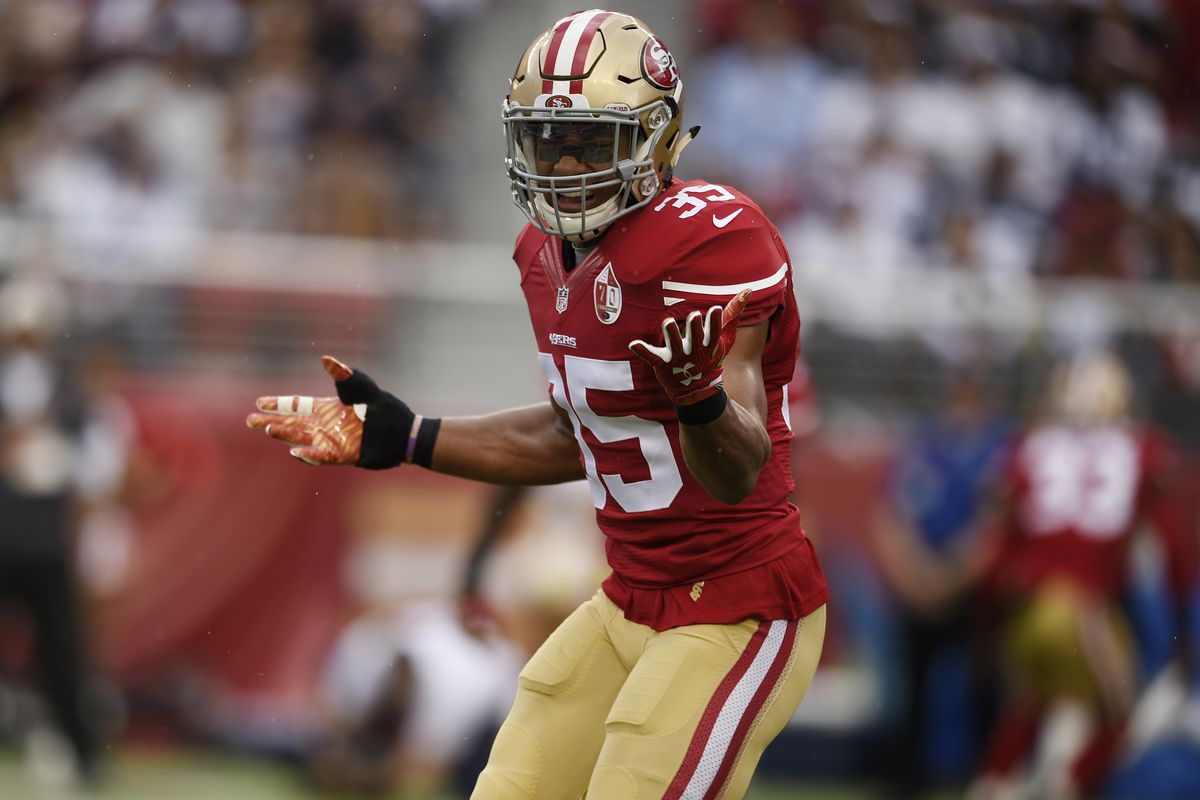Man Coverage
Reid was used in a range of ways in the 49ers defense last season, and with both he and Adams able to play in the box and deep, it is likely that the Panthers look to use both of them in a range of ways to force defenses to adapt to a range of looks throughout games. In many ways, the simplest coverage that any team runs is man coverage, and it is certainly something the Panthers’ defense has moved towards since the departure of Sean McDermott.
As a safety, Reid will likely see most of his man coverage assignments against tight ends and running backs, with the limiting factor for most defenders in man coverage being their ability to run man-for-man with receivers down the field. On tape last season, Reid shows the ability to run in-stride with even the fastest tight ends:
This speed also shows up on underneath routes, in combination with good lateral agility, this allows him to follow receivers even through the most complex of routes:
Even though he gives up the touchdown on this play, he is in good position throughout and the touchdown requires an extremely well-placed throw and a non-trivial catch. As with Tyler Eiffert’s catch over Colin Jones last Sunday, even good coverage can’t prevent every completion, but by increasing the level of difficulty, the odds of the pass being completed are dramatically reduced. Where a lot of man coverage reps are won and lost, however, is at the head of the route – this is where Reid does some of his best work.
Where some defenders make a mistake is being too stationary at the head of the route, not wanting to give the receiver too much space. While Reid doesn’t back up a huge amount, he makes sure to get his feet moving before the receiver reaches the head of the route by taking small, regular steps. This both gives him some momentum and puts his feet behind him, making it easier for him to drive on either lateral or backwards breaks:
This is possibly clearest when shown in contrast with a play where he does make a mistake, such as on the following play:
Here, his final outwards step is just slightly too deep, meaning that when the receiver breaks inside, his body weight is largely towards the outside of his frame, causing him to take that extra micro-second to break inside – this allows the receiver to generate enough separation to make the catch. Usually, when a defender is in man coverage, he has help either inside, outside or over the top; many defenders look to combine multiple of these in order to limit the risk of a big play. However, something the Panthers have done at times this season is to have a safety over the top but no help either inside or outside of the defenders. Without help over the middle of the field, defenders often look to force outside leverage in these situations, looking to use their body to wall off inside routes and focus their attention on routes breaking to the outside of the field. Reid does an excellent job of this on the following play:
This is, however, extremely hard to do, and Reid isn’t always perfect. The one mistake he did make that could be addressed is that he occasionally opens up his hips before the receiver gets deeper than his inside leg. This allows the receiver to break clean across him and get relatively easy inside separation:
If he waits a little longer to allow the receiver to get that shade deeper, he will then be able to use his body to inhibit any inside breaking routes. This is, however, only the slightest of nitpicks, and Reid is in general an excellent man coverage defender. On all of the following plays, Reid is patient enough to keep relatively square up until the head of the route, forcing contact that cannot be flagged – it is simply a defender holding his position, which in turn disrupts the timing of the route:
Besides this ability to stay with his man, Reid shows great awareness in man coverage. This is hinted at by the frequency with which he is able to get his back to the ball on the plays above, but is most evident on plays like the following where, after no receivers get open, Russell Wilson breaks the pocket and looks to pick up the first down with his legs. Against man coverage, this is a play that will work the vast majority of the time, as defenders tend to be watching their receivers rather than the quarterback. What Reid is able to do, however, is stay close to his man while keeping his eyes on the quarterback, so when Wilson leaves the pocket, Reid is able to come up to tackle him short of the first down:
By consistently getting his head around to face the ball while staying close to his receiver, Reid is not only able to act as a pseudo-spy on broken plays, but is able able to put himself in position to use his ball skills to make plays on the ball:
This play is an excellent demonstration of Reid’s speed, fluidity, awareness and ball skills, and if the Panthers get anything close to this quality from Reid, they will have got themselves one hell of a good man cover safety.



